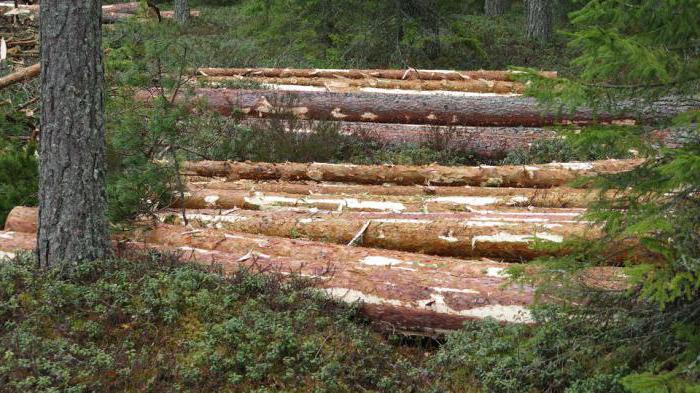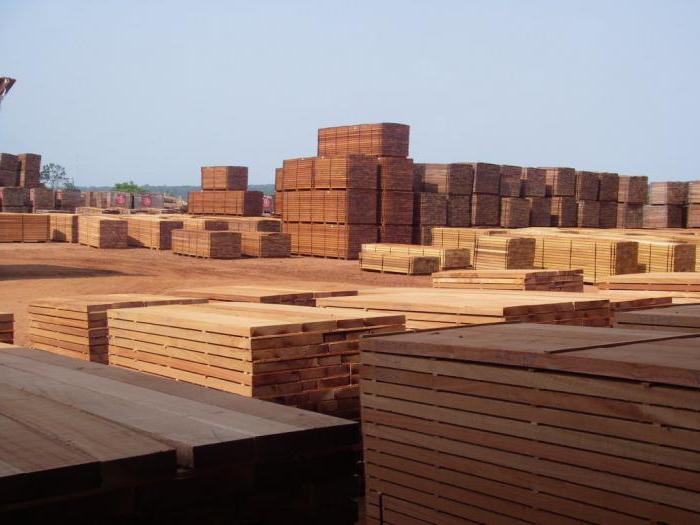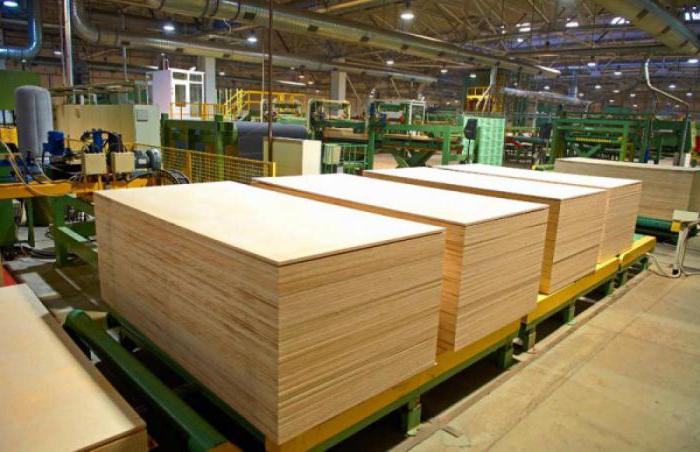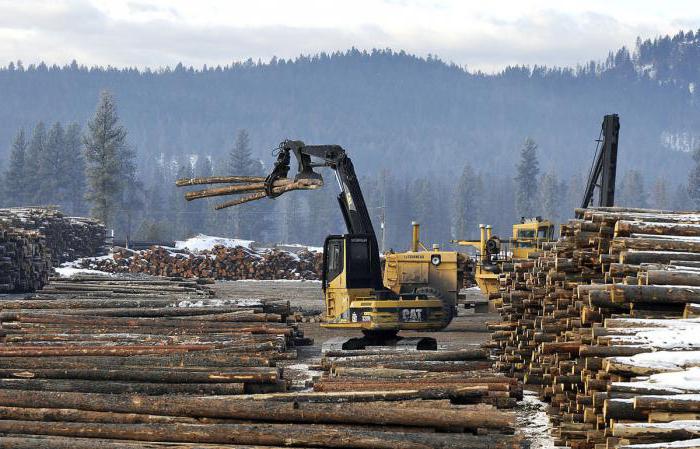Russia's timber industry is a combination of industrial sectors, one way or another connected with the harvesting and processing of wood. This area of economic activity is one of the oldest. This article will consider the composition of the timber industry of the Russian Federation and its current state.
general characteristics
On the territory of the Russian Federation is a quarter of the world's wood supply. Forests occupy about 45% of the state’s area. The main share of forest-forming species is formed from conifers: spruce, pine, larch and cedar.
The country's forest fund is divided into three main groups:
- Protective, waterproof, protected and recreational forests. In such areas, felling is carried out only for sanitary reasons.
- Territories in which felling is carried out selectively and does not exceed annual growth.
- Production arrays in which continuous cutting of commercial timber is carried out.

Structure
The timber industry complex (LPC) has a rather complex structure. All its branches can be conditionally divided into four large groups:
- Logging industry. Responsible for timber harvesting.
- Woodworking industry. Engaged in the processing (mechanical and chemical-mechanical) of wood and its processing. The enterprises of this group make furniture, procure lumber and so on.
- Pulp and paper industry. It involves mainly chemical processing of wood. The enterprises of this group produce paper, cardboard, pulp and other products.
- Wood chemical industry. This includes the production of products such as coal, rosin, turpentine, etc.
Forest Economics
The sectors that are part of the Russian timber industry take 7th place in terms of production volumes and 5th in terms of product exports. The largest timber industry complexes of Russia are located in such regions: the European North, Eastern and Western Siberia and the Far East. Here it is second only to metallurgy and the fuel industry.
Currently, the main product of the industry is business wood - its share among the total exported forest products ranges from 75 to 80%. Logging is considered the basic direction of the entire timber industry complex in Russia. At the end of the 80s of the last century, the Soviet Union in the world ranking was second only to America in terms of timber export. After a series of economic transformations of recent decades, Russia has moved to the 6th-7th place in this list.
As in other industries of the Russian Federation, based on the extraction and subsequent renewal of raw materials, in forestry, the main revenue is generated from the sale of raw materials for export. In this case, it is a round forest (the so-called round timber). For a long period, Russia was considered the main supplier of this raw material to China, Japan, the Middle East and Europe.

In July 2007, the Russian government decided to increase customs duties on roundwood exports by 20%. In April next year, this figure increased by another 25%. According to analysts at Lesprom Network, such a government decision has led to a significant decrease in the competitiveness of large timber industry complexes of the Russian Federation that rely on exports.
The impact of the global crisis
At the end of 2008, due to the global economic crisis, construction volumes fell sharply in Western Europe, China and Japan.Together with them, the volumes of output of the timber industry complex in the sectors consuming wood decreased. In 2008, the volume of logging in the Russian Federation was reduced by 14.4% compared to the previous year. At the same time, even a slight increase was observed in woodworking and pulp and paper production: 1.4 and 0.8%, respectively.
The net profit ratio of enterprises of the timber industry of the Russian Federation in 2008 also fell sharply, which is confirmed by the information of the annual rating of the Forest Industry magazine. According to the publication, the total revenue of the companies included in the top 50 amounted to a little more than 216 billion rubles. 70% of this amount accounted for the top ten ranking leaders. The share of enterprises specializing exclusively in wood processing amounted to 27% of total revenue.
The specifics of the development of the timber industry
In addition to geographical features, there is a general specificity of the industry. Recently, there has been a decrease in the share of paper and paper products and an increase in the share of substitute goods. For example, the active introduction of plastic packaging has reduced paper output, and the development of the Internet has affected the consumption of newsprint.
Private ownership of forest land in Russia does not exist. It is replaced by long-term leases for logging and recreational purposes. However, there are a number of countries where it is quite possible to obtain private ownership of land. For example, in America, forest land management is a big business with a turnover of up to $ 500 billion. The forest there occupies about 0.5 billion acres. Of these, 53% are owned by private owners (not industrialists), 30% are publicly owned, 4% are owned by industrialists, and the remaining 8% are owned by financial investors.
The largest companies in the forestry industry of the Russian Federation for 2017 (revenue is indicated in parentheses) are:
- Ilim Group (112 billion rubles).
- Mondi SLPK (55 billion rubles).
- "Segezha Group of Companies" (43 billion rubles).
- International Paper (42 billion rubles).
- Sveza (31 billion rubles).
We will get acquainted with the structure of the timber industry of the Russian Federation, having examined its main sectors.
Lumber production

In the global market, Russian-made lumber is in great demand. The main reason for this is the high quality of products. Lumber from Siberia and the Northwest region, which have high processing strength and dense structure, are especially valued. The small and large timber industry complexes of the Russian Federation had to use this trump card when the government imposed large duties on the export of round timber. So, since the beginning of 2010, the volume of deliveries of coniferous lumber abroad began to grow. The main sales are in China, Uzbekistan, Egypt, Iran and Japan.
Among the federal districts, the largest volume of production falls on Siberia, which produces up to 40% of the total volume in the country. The North-West district (28.4%) is in second place, and Privolzhsky (11%) is in third. The established distribution of shares in total production reflects the geographical location of the timber processing enterprises.
Pulp and paper industry
As statistics show, the pulp and paper industry is the largest (in value terms) branch of the timber industry of the Russian Federation. Gradually, large industrial and financial associations formed in this industry that control the bulk of production.
In 2016, industry growth was observed in all major products:
- Wood pulp - by 4.2%.
- Paper - by 2.3%.
- Cardboard - by 3.3%.
But the production of boxes of corrugated cardboard was almost halved.
As the name implies, the main products in this industry are cellulose. Its production capacity is estimated at 9.5 million tons. On average, their annual load is 62%.The largest volumes of cellulose are produced in such cities: Bratsk, Ust-Ilimsk, Arkhangelsk and Kotlas. They account for up to 90% of the country's output.
Paper and paperboard capacities are estimated at approximately 9 million tons. At the same time, in terms of per capita, Russia produces only 33 kilograms of paper per year. It seems that this is quite a lot, but there are countries in which this indicator reaches more than 300 kg. Of the problems in this sector, a narrow range of products can be noted. The largest paper companies are located in such cities: Balakhna, Syktyvkar, Solikamsk, Svetogorsk, Segezha and Kotlas. As for cardboard, it is most produced in Arkhangelsk, Syktyvkar, Bratsk, Naberezhnye Chelny and St. Petersburg.
Plywood production
This material has found wide application in the manufacture of furniture, construction, as well as transport engineering. More than 50% of products manufactured in Russia are exported. In 2016, the volume of plywood production in the Russian Federation amounted to 3.65 million m3. Of these, 2.55 million were sold abroad.

The industry is actively updating equipment. The main production resources are concentrated in the zone of mixed forests and in the south of the taiga. The largest manufacturers were also located there. The leaders in the production of plywood are the Republic of Komi and the Kostroma region. Large enterprises are also located in: Irkutsk, Novgorod, Vologda, Leningrad regions and Perm Territory.
As statistics show, from 2010 to 2016. plywood output increased 2.5 times. Production is divided approximately equally between three groups of enterprises: plants of the Sveza group, second-tier plants, and small producers. In terms of plywood exports, the Russian Federation is steadily holding fourth place, second only to China, Indonesia and Malaysia.
Match production
Making matches from aspen is a traditional sub-sector for the Russian Federation. Almost all companies, with some exceptions, are located in the European part of the state. The largest producer is the company “Speechplitprom”, located in the Kaluga region. Smaller enterprises are located in the Bryansk, Novgorod, Yaroslavl, Penza, Kirov, Sverdlovsk, Tomsk regions, as well as in the Altai Territory and Bashkiria.
Last time, the production of matches began to decline sharply. If in 2006 Russia produced 8 million standard boxes, then by 2014 this figure dropped to 2.4 million. The main reasons for this trend are: outdated equipment, low profitability, and, of course, the growing market for lighters.
Furniture industry
In the 1980s, the furniture industry of the Soviet Union was notable for a large share of manual labor, insufficiently qualified employees and high wear of equipment. As a result, in terms of volume, quality and technological parameters, the manufactured products did not always correspond to the needs of the consumer. Another problem was that the country did not produce special equipment for furniture factories.
With the introduction of economic reforms of the 1990s, the situation has changed. A large selection of products, materials, components and technologies has been formed. And even the crisis of the late 1990s, the furniture industry successfully overcame, without losing highly qualified personnel and production potential.

Between 2000 and 2008 The furniture market has been actively developing. Every year, sales of products increased by an average of 23%, taking into account changes in prices. If in 2009-2010, due to the crisis, a significant decline in production was observed, then in 2011-2012 the volume of furniture production exceeded even the pre-crisis level. However, the country's entry into the WTO has led to an increase in the share of cheap imports.As a result, the main competitive advantages of Russian furniture (low cost of material and low labor costs) have lost their force.
Since 2014, when foreign suppliers have become uncompetitive due to the growth of the dollar, everything has returned to their places. In 2016, the share of domestic producers in the domestic market amounted to more than 80% in volume and up to 63% in value terms. As for the export of furniture from the Russian Federation, since the beginning of the new century it has remained at a low level, significantly inferior to exports. In 2015, the share of the Russian Federation in world furniture production was less than 1%. In comparison, the share of America is 27%, Japan, Germany and Italy - 9%, and China - 7%.
About 5-6 thousand enterprises are engaged in the production of wooden furniture in Russia. Of these, only fifteen annual turnover exceeds 1 billion rubles. These enterprises account for approximately half of the production. About five hundred companies have a turnover of 0.3-1 billion rubles and are classified as medium-sized businesses.
The furniture industry is the only segment of the timber industry complex whose centers are remote from the main areas of raw material extraction. The lion's share of enterprises is concentrated in the Central (Moscow, Yaroslavl and Ryazan regions), North-West, Volga and Southern districts. They occupy 86% of the furniture market. The leader is the Central District, which accounts for almost half of all production. Thus, a paradoxical phenomenon is observed in the furniture industry of the Russian Federation - the main facilities are located in non-forest areas, which is not typical for the timber industry. So, in the Far East and Siberia, where the largest woodworking companies are located, there are no large centers for the production of furniture.
Pellet production
This industry is new and rapidly developing for Russia. Pellets, being environmentally friendly fuel, are otherwise exported to European countries. The main manufacturers are concentrated in the Krasnoyarsk Territory, Arkhangelsk, Tver, Vologda Oblasts and Karelia. Due to the unlimited raw material base, the industry has great opportunities for growth. So far, in comparison with the world market, pellet production volumes in Russia are insignificant. According to various sources, they make up from 0.9 to 1.5 million tons, which, even with the most positive assessment, does not reach the level of Latvia.

The development of the biofuel sector in the Russian Federation is regulated by a number of state programs for the coming decades. However, according to experts from the journal Forest Industry, the intended goals are not clear enough. According to government programs, by 2020, 4.5% of electricity in Russia should be produced using alternative sources. For example, in Norway this indicator reaches 67%, in Sweden - 50%, and in Latvia - 40%.
With the growth of biofuel consumption in the countries of Central Europe, the latter will begin to experience a lack of forest resources, therefore they will rely on the import of pellets. Russia has every opportunity to occupy a large part of this market, however, for this it needs to establish relations with Europe. The main competitors of the Russian Federation in this field are Canada, America and Brazil, which have large reserves of biofuel raw materials.
Problems and prospects of the timber industry
The forest industry in Russia has accumulated many problems that need to be resolved quickly. The material and technical base of the complex is very worn out - it is necessary to modernize up to 70% of production assets. Most loggers suffer from a lack of own funds. In addition, the industry is not experiencing a sufficiently high labor productivity. The urgent tasks of the forest industry today are: changing the raw material orientation of exports and increasing the depth of processing of products.
The following measures contribute to the solution of these problems:
- Implementation of a voluntary certification system.
- Creation of a single base for controlling the harvesting and movement of resources, including wood labeling.
- Creation of an electronic exchange with fixing all sales transactions, as well as an electronic database of logging tickets.
These measures will make it possible to control all stages of wood production, increase the level of business legality and strengthen the position of the timber industry in the international market.

Today, the state does not have the opportunity to exert strategic influence on the forestry complex, since the national forest policy is not endowed with consistency and specificity, as in all major logging countries. Moreover, the state strategy for the development of the timber industry complex often contains conflicting, duplicative, or even mutually exclusive provisions. In addition to this, there is unpredictable tax legislation and a regularly changing regulatory framework. All this greatly complicates the activities of timber enterprises that want to work honestly. And one-day companies of that time, barbarously cut down large tracts of forest leased, without incurring any moral and legal responsibility. The situation is complicated by “corporate wars”, because of which foreign investors are wary of investments in the Russian forest business.
Considering the problems of the timber industry of the Russian Federation, one cannot but mention the constantly rising prices for electricity, gas and rail transportation. All this leads to a decrease in the competitiveness of domestic enterprises.
The development strategy of the Russian timber industry should be based on the rational use of the existing stock of resources and the realization of the state’s natural advantages.
The main areas of development are:
- Organization of intensive but not depleting forest use.
- Technical re-equipment of companies and modernization of forestry engineering.
- Stimulation of complex and deep processing of raw materials.
- The introduction of resource-saving technologies and equipment.
- Establishing a system of economic relations.
- Development of a forest management system at the country and region level.
- The development of the legislative framework.
- Improving the tax and customs regime.